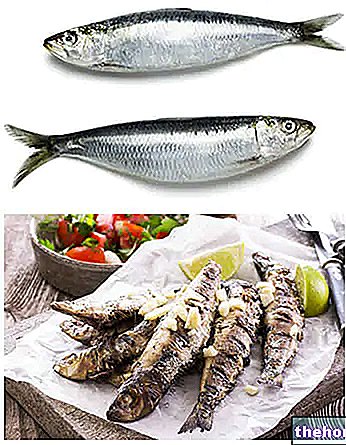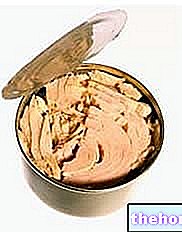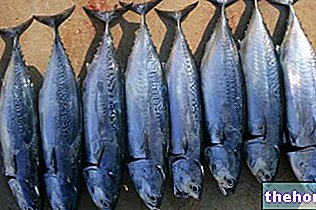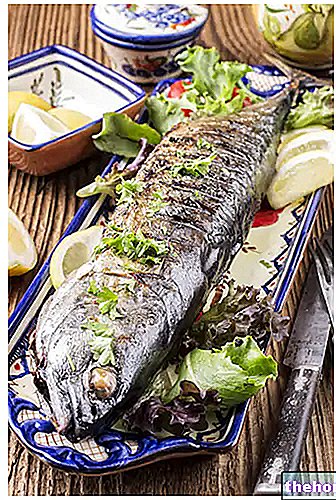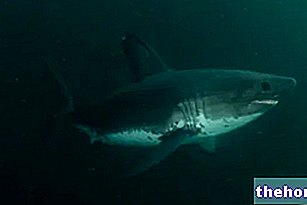Generality
The "sword" (in English swordfish) is a fish belonging to the Xiphiidae family, Genus Xiphias, Species gladius. The binomial nomenclature of swordfish is Xiphias gladius.

Swordfish contains good percentages of essential fatty acids, which is why it is often included in clinical nutrition diets. It lends itself to many types of preparations, from "raw" to steak on the grill. As far as the hygienic aspect is concerned, it does not differ from the rest of the blue fish, a group of which it is a worthy exponent.
Nutritional and Gastronomic Characteristics
Swordfish is an extremely protein food, characterized by a high biological value of the peptides that compose it.
Being particularly thin, it does not provide large quantities of energy and the few fatty acids it contains are mainly of the essential polyunsaturated type of the omega 3 group; cholesterol is rather moderate.
Carbohydrates and fibers are absent.

Nutritional values (per 100 g of edible portion)
The vitamin fraction is very good; there are excellent quantities of pyridoxine (vit. B6), niacin (vit. PP), retinol (vit. A) and cobalamin (vit. B12). As for the saline profile, the quantities of selenium, phosphorus and potassium are excellent.
Swordfish lends itself to any nutritional regimen, except for pregnant women. This is due to the considerable presence of mercury which, on the other hand, is decidedly more scarce in smaller specimens. However, considering that it is NECESSARY to allow young fish to carry out different reproductive cycles, it is advisable to eat mainly adult swordfish but ONLY in the absence of pregnancy and with an EXTRA weekly frequency (to be added to that of other large fish, such as tuna and shark).
We remind you that swordfish is suitable for the diet against overweight, hypercholesterolemia, hypertriglyceridemia, diabetes and hypertension.
If eaten raw, swordfish MUST necessarily be blast chilled; this precaution (also essential for other fish) is essential to eliminate any larvae of anisakis which, if introduced alive with food, can become extremely harmful for the organism.
Example of a main meal based on swordfish
- 200 grams of grilled swordfish (making sure that the classic dark lines, rich in carcinogenic substances, do not form)
- 200 grams of grilled zucchini
- 200 grams of fresh tomatoes
- 100 grams of bread (durum wheat)
- 10 grams of olive oil
TOTAL CALORIES: 610 Kcal *
CARBOHYDRATES: 60 g
FATS: 21 g
PROTEIN: 49 g
* this swordfish-based recipe provides the same calories found in: 100 grams of mortadella plus 100g of focaccia; or in: 80 grams of roasted and salted pistachios plus a can of coke.
Swordfish is a typical fishery product of the Calabria and Sicily regions. It is prepared in many ways but, probably, the best known recipes are: grilled or grilled, with carpaccio (fresh or smoked), in a pan with cherry tomatoes, capers, black olives and oregano, in mixed soup, in pasta sauce and baked in the oven.
Tips for shopping
The swordfish steaks must have a delicate and pleasant smell, not ammoniacal. The pulp must be compact and slightly pink, not yellow. Pressing a finger on the meat should NOT remain the fingerprint, as this is an indication of poor freshness.
At the supermarket you can come across slices marketed as swordfish but coming from other fish of similar size such as shark. If the swordfish is not exposed with the head, to ascertain its origin it is necessary to observe the meat on the sides of the vertebra: only if it has darker lines that form an "x" is it real swordfish.
Pasta della Salute with swordfish
A light and balanced first course to fill up with precious nutrients for health. Enjoy and enjoy your meal!
Pasta of health
Problems with playing the video? Reload the video from youtube.
- Go to the Video Page
- Go to the Video Recipes Section
- Watch the video on youtube
Description
This predator is characterized by a long and thin bone extension of the jaw, similar to a real sword (over 1 meter in length); this natural weapon is used for defense or hunting, to stun the victims in order to devour them in comfort.
The body of the swordfish is tapered, hydrodynamic; not surprisingly, it is one of the fastest migratory fish on the planet. It is dark on the back (tending to blue or brown), silver on the sides and white on the belly. It can reach and exceed 4 meters in length for a weight of 300kg.

Biology, Habitat and Fishing
Swordfish fishing is carried out both professionally and as an amateur. In Italy there are very strong traditions, such as the Calabrian and Sicilian ones, still carried out today with traditional methods (spadare); these are methods with an almost zero environmental impact even if, at the same time, there is a real fish massacre (which does not only affect the sword) by means of gillnets several kilometers long (often used between Calabria and the islands Aeolian Islands). The amateur activity is totally different; it is practiced with rods by means of trolling, while the samples taken by spearfishermen in apnea are only occasional.
The swordfish is an animal that colonizes almost the entire planet, in the temperate range. In the Mediterranean Sea (but not only) it is considered an endangered species and, even in places where artisanal fishing was based on its capture (to indicate a "high density of population, such as in the Strait of Messina), today swordfish is In some countries, such as the USA, swordfish fishing has been prohibited, and various figures of reference, such as the chefs of the most famous restaurants, also contribute to supporting this attitude of protection.
As anticipated, swordfish is an excellent predator. It feeds on other blue fish, such as mackerel, lanzardi, garfish, sardines, anchovies, small barracudas, small bonito, small dolphin fish, small holm oaks, small greenhouses, small amberjacks, flying fish, cuttlefish, squid, squid, herring, alaccie etc. In addition to man, who is responsible for the decimation of its density in the seas around the world (in particular in the Mediterranean which, as is known, is a basin relatively communicating with the oceans), the swordfish fears ONLY the shark.
The swordfish has the incredible ability to raise the temperature of its brain and eyes (through the blood) to increase the vision potential. It lives mainly in the open sea, up to 600m deep, and is NOT typical of the low coastal coast. - degrading. It has no gregarious predisposition and it is a solitary creature. It breaks this routine only for mating (between spring and summer, with the water at about 24 ° C), after which a deposition of several millions of eggs; the crossing occurs mainly between specimens that come from the same area.
Fish, Molluscs, Crustaceans Anchovies or Anchovies Garfish Alaccia Eel Lobster Herring Lobster Whitebait Bottarga Sea bass (Sea bass) Squid Canocchie Scallops Canestrelli (Sea scallops) Capitone Caviar Mullet Monkfish (Monkfish) Mussels Crustaceans Dates Sea Fruits Fish Flour Fauna Fish stock Prawns Crabs Spider crab (Granceola) Halibut Sea salad Lanzardo Leccia Sea snails Prawns Cod Molluscs Octopus Hake Ombrina Oysters Sea bream Bonito Pangasius Paranza Anchovy paste Fresh seasonal fish Blue fish Puffer fish Swordfish Plaice Octopus (Octopus) Hedgehog of Sea Amberjack Salmon Sardines Sardines Scampi Cuttlefish Mackerel Sole Stockfish Surimi Sushi Telline Tuna Canned tuna Mullet Trout Fish roe Bluefish Clams OTHER FISH ARTICLES Categories Alcoholic Food Meat Cereals and derivatives Sweeteners Sweets Offal Fruit Dried fruit Milk and derivatives Legumes Oils and fats Fish andpeach products Salami Spices Vegetables Health recipes Appetizers Bread, Pizza and Brioche First courses Second courses Vegetables and Salads Sweets and Desserts Ice creams and sorbets Syrups, liqueurs and grappa Basic preparations ---- In the kitchen with leftovers Carnival recipes Christmas Light diet recipes Women's, mom's and dad's day recipes Functional recipes International recipes Easter recipes Celiac recipes Diabetic recipes Holiday recipes Valentine's Day recipes Vegetarian recipes Protein recipes Regional recipes Vegan recipes

